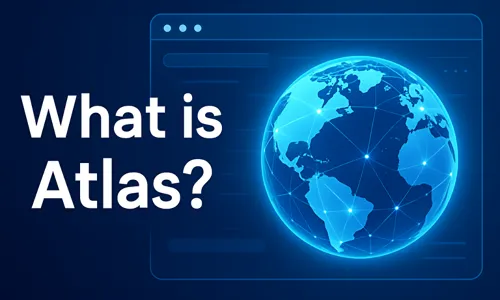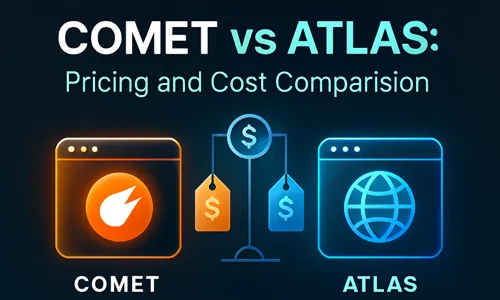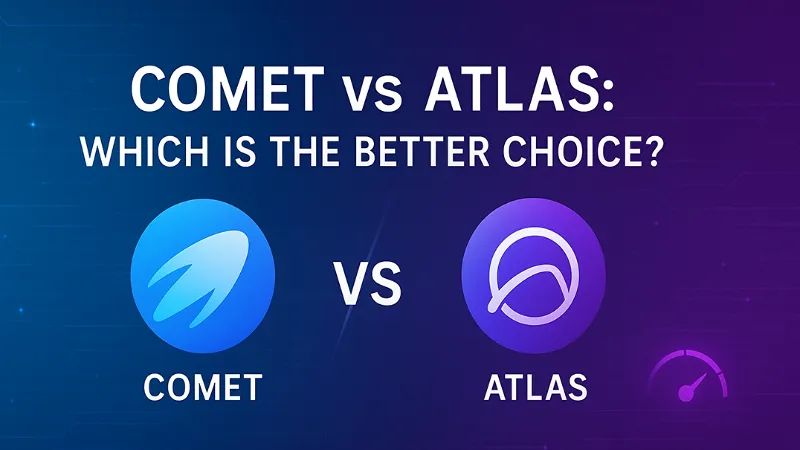When choosing between Comet and Atlas, it’s easy to get caught up in feature lists and marketing claims. The Comet vs Atlas debate has become increasingly relevant as both platforms continue to gain popularity among data professionals, developers, and machine learning engineers. Each offers powerful solutions in its domain – Comet focusing on machine learning experiment tracking and model management, while Atlas stands out as a robust cloud database service designed for scalability and data-driven applications. Understanding the differences between Comet vs Atlas, including aspects like the Comet vs Atlas comparison and the emerging Comet vs Atlas browser discussions, can help you select the right tool for your needs, whether you’re optimizing AI workflows or managing large-scale data infrastructure.
In this Comet vs Atlas comparison, we’ll break down their key features, usability, pricing, and performance to help you make an informed decision. Related keywords for this topic include Comet vs Atlas browser, Comet or Atlas differences, Comet vs Atlas analysis, and Comet or Atlas review – all of which highlight how these platforms cater to different but complementary data needs.
What is Comet?

Comet is widely recognized as an advanced machine learning experiment tracking and model management platform that empowers teams to manage and optimize their AI projects efficiently. In the Comet vs Atlas comparison, Comet stands out for its ability to track, compare, and reproduce experiments with ease, offering a seamless interface for data scientists and researchers. It integrates smoothly with popular frameworks like TensorFlow, PyTorch, and scikit-learn, enabling automatic logging of metrics, parameters, and code versions for reproducible research.
Comet’s real-time experiment monitoring and data visualization tools make it invaluable for organizations focused on deep learning and predictive analytics. Through its intuitive dashboards, users can perform advanced analytics, compare model performance, and collaborate with team members efficiently. The platform also supports integrations with Jupyter Notebooks, Google Colab, and major cloud providers, enhancing its accessibility for diverse AI workflows.
What is Atlas?

Atlas, commonly known as MongoDB Atlas, is a fully managed cloud database platform that excels in data scalability, flexibility, and performance. In the context of the Comet vs Atlas comparison, Atlas shines as a solution for data storage, management, and cloud deployment. It allows developers to build modern, data-driven applications with minimal maintenance effort by automating essential database operations such as scaling, backup, and performance optimization.
Atlas supports multi-cloud deployment, enabling users to run their databases seamlessly across AWS, Google Cloud Platform (GCP), and Microsoft Azure. This makes it an ideal choice for enterprises requiring high availability and global data distribution. Atlas also includes advanced features such as end-to-end encryption, real-time analytics, and automated performance tuning, ensuring both security and efficiency in production environments.
For teams exploring Comet and Atlas browser or Comet vs Atlas integration workflows, Atlas provides a reliable backend for storing massive datasets that can complement Comet’s experiment tracking capabilities. Developers benefit from its developer-friendly UI, flexible document model, and strong integration with BI tools, making it a powerhouse for modern app development and analytics.
While Comet focuses on AI experiment tracking and collaboration, Atlas dominates the database management and scalability side of the equation — making both platforms essential tools in data-centric workflows.
Comet vs Atlas: Key Features Comparison

The Comet vs Atlas key features comparison is crucial to understanding how each platform serves different needs in the data and AI landscape. While Comet specializes in machine learning experiment tracking, Atlas excels in cloud database management. In this section, we’ll explore the primary features, integrations, scalability, and overall usability of both platforms in depth.
Comet provides a comprehensive suite of tools for managing and visualizing machine learning experiments. It allows users to log hyperparameters, track model performance, visualize metrics in real time, and collaborate efficiently across teams. Its integration with popular AI frameworks like TensorFlow, Keras, and PyTorch makes it a favorite among data scientists. Additional features such as version control for models, automatic metric logging, and dataset management strengthen Comet’s position as a leader in the MLOps ecosystem. Users researching Comet vs Atlas browser compatibility or Comet vs Atlas workflow integration often note Comet’s strong adaptability in both local and cloud environments.
Atlas, on the other hand, shines in data infrastructure. It offers automated scaling, global clusters, and advanced security features that cater to organizations handling vast amounts of data. MongoDB Atlas ensures seamless database performance through real-time analytics, flexible document storage, and multi-cloud support across AWS, GCP, and Azure. In terms of Comet vs Atlas comparison for developers, Atlas provides robust APIs and simplified management dashboards that make it a top choice for application backends and analytics pipelines.
| Feature | Comet | Atlas |
|---|---|---|
| Primary Use | ML experiment tracking & management | Cloud database management |
| Data Handling | Logs metrics, parameters, and model versions | Stores, queries, and scales structured/unstructured data |
| Collaboration | Shared dashboards, experiment insights | Multi-cloud database access and shared clusters |
| Integrations | Works with TensorFlow, PyTorch, scikit-learn, etc. | Integrates with AWS, GCP, Azure, BI tools |
| Security | Data encryption & workspace controls | End-to-end encryption, access controls, network isolation |
| Scalability | Scales with number of experiments | Scales storage, compute, and regions automatically |
| Ease of Use | Great for ML teams; simple API integration | Intuitive UI; minimal DevOps overhead |
he Comet vs Atlas feature comparison highlights two complementary technologies: Comet excels in AI experiment tracking, while Atlas dominates data management and scalability. Whether you’re focused on model performance analytics or enterprise-grade data storage, both tools offer robust and reliable functionality.
Comet vs Atlas: Performance and Reliability
In the Comet vs Atlas performance and reliability comparison, both tools deliver impressive results, but their strengths vary according to use cases.
Comet performs exceptionally well when managing machine learning workloads. It’s optimized for real-time experiment tracking, performance visualization, and model evaluation. The platform ensures reliable tracking of thousands of experiments with minimal latency, even in distributed computing environments. Users exploring Comet vs Atlas browser performance often note Comet’s ability to handle large experiment logs and real-time updates efficiently.
In contrast, Atlas is designed for high-performance database management. Its 99.99% uptime guarantee, automated failover, and multi-region replication ensure uninterrupted service. Atlas leverages intelligent sharding, query optimization, and global clusters to deliver lightning-fast responses for high-traffic applications. Developers looking at Comet vs Atlas reliability find that Atlas excels in scalability, data redundancy, and backup automation, making it ideal for enterprise-grade deployments.
Comet vs Atlas: Pricing and Cost Comparison

When comparing Comet vs Atlas pricing, both offer flexible models to fit different organizational needs.
Comet provides a free plan ideal for individuals or small teams to start tracking experiments, along with paid tiers that unlock advanced collaboration, integrations, and enterprise-grade features. Its transparent pricing ensures predictable costs, making it popular among data science teams and research organizations seeking value-based pricing. In Comet vs Atlas pricing comparisons, Comet often stands out for offering significant functionality at lower cost for AI-focused use cases.
Atlas uses a usage-based pricing model, where users only pay for the resources they consume. It includes a free M0 cluster tier for experimentation and small projects, while enterprise customers can scale to powerful dedicated clusters with advanced monitoring, security, and analytics. Businesses analyzing Comet vs Atlas pricing models appreciate Atlas’s flexibility, which allows dynamic cost adjustments as data workloads grow.
Overall, in the Comet vs Atlas pricing comparison, Comet is cost-efficient for ML experiment tracking, while Atlas offers scalable and customizable pricing suited for long-term data infrastructure investments.
Ideal Use Cases
The Comet vs Atlas ideal use cases comparison reveals where each tool excels, helping organizations align their technology stack with specific goals.
Ideal Use Cases for Comet
Comet is purpose-built for teams that prioritize machine learning experimentation, collaboration, and transparency. It’s a perfect fit for:
- AI research teams that need to track hundreds of experiments efficiently.
- Data science departments requiring model version control, reproducibility, and real-time visualization.
- Startups and enterprises focused on deploying machine learning workflows with integrated MLOps.
Comet enables teams to streamline their ML pipeline – from training to monitoring – and supports integrations with cloud services and frameworks like TensorFlow, PyTorch, and Keras. In Comet vs Atlas browser and workflow comparisons, Comet often leads in providing custom dashboards and metrics tracking tools for continuous model improvement.
Ideal Use Cases for Atlas
Atlas (MongoDB Atlas) shines in scenarios involving data storage, scalability, and backend performance. It’s best suited for:
- Developers building large-scale web or mobile applications that demand high availability and low latency.
- Businesses managing global databases or multi-region cloud infrastructures.
- Data-driven organizations leveraging real-time analytics, IoT data ingestion, or scalable APIs.
Atlas’s multi-cloud support, end-to-end encryption, and automatic scaling make it the go-to choice for mission-critical applications. In Comet vs Atlas integration comparisons, Atlas frequently complements Comet by storing datasets and experiment outputs in a secure, distributed environment.
Combining Both Platforms
For many teams, the best approach isn’t choosing one over the other but using Comet and Atlas together. Comet can handle AI model tracking, while Atlas manages the data storage and performance layer. This combination allows seamless integration between data collection, experiment management, and deployment.
the Comet vs Atlas use cases highlight two complementary tools – one focused on advancing machine learning experiments, and the other dedicated to managing scalable, high-performance databases.
In conclusion, the Comet vs Atlas comparison reveals that both platforms are powerful in their respective domains. Comet stands out for its exceptional machine learning experiment tracking, collaboration tools, and MLOps capabilities, making it ideal for AI-focused teams and research projects. Atlas, on the other hand, dominates the field of cloud database management, offering unmatched scalability, performance, and data security for developers and enterprises.
Whether you’re evaluating the Comet vs Atlas browser integration, comparing Comet vs Atlas pricing, or deciding which fits your workflow better, the key is understanding your project’s priorities. For machine learning experimentation, Comet is the clear winner; for data storage and scalability, Atlas is the preferred solution.
In many modern tech stacks, both tools complement each other perfectly – Comet manages the experimentation and tracking layer, while Atlas powers the backend with robust data management. The Comet vs Atlas analysis ultimately proves that choosing both can help teams build more efficient, scalable, and data-driven AI ecosystems.
Frequently Asked Questions (FAQs)
Yes. Comet is specifically designed for machine learning experiment tracking, making it the better choice for ML projects compared to Atlas.
No. Atlas serves as a cloud database platform, not an ML experiment tracker, so it’s not a direct replacement for Comet.
Yes. Many teams integrate Comet and Atlas to combine experiment tracking with secure data storage and scalability.
Yes. Comet provides a free tier suitable for individual users, with paid options for teams and enterprises.
Yes. Atlas excels at managing, scaling, and securing data for web, mobile, and enterprise applications, while Comet focuses on model management.







